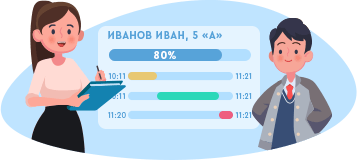– Hello, boys and girls! My name is Bobby.
– And my name is Tobby. This is our friend Mobby.
– Welcome to our lesson!
– Today we have a guest.
– It’s a little chicken.

– Hello, boys! My name is Queen.
– Oh, hello! Nice to meet you!
– Nice to meet you too, boys!
– Well… Queen, what brought you here today?
– Boys, I’ve come to you, because I need your help.
– Oh, and what kind of help do you need?
– Well… Yesterday my mum told me that it’s time for me to enter some school!
– Oh, that’s great!
– Yeah, I agree! But I don’t see any problem here.
– Oh, it’s not a problem! The problem is that I don’t know which school to choose!
– Oh, I see! Choosing the school is a responsible task!
– Queen, would you like us to tell you about the types of schools in the UK?
– Boys, that would be awesome!
– Great! In this case, listen to us very attentively!
So today in the lesson we will:
· talk about the types of schools in the UK;
And
· put the knowledge into practice.
First, we should mention that school is a place where children go to be educated. Pupils spend half of their day or even more there. That’s why it’s very important to choose the right school.

– Queen, now we will talk about the types of schools.
– But before we do that, let’s learn some new words.
– You’ll need them to understand the information.
– And the words are…
Age
The translation is “возраст”.
Abilities
The translation is “способности”.
Senior pupil
The translation is “старшеклассник”.
Lesson
The translation is “урок”.
Education
The translation is “обучение, образование”.
Great! Now let’s talk about the types of schools.
There are three main types of schools:
· Nursery schools
Детские сады
· Primary schools
Начальные школы
And
· Secondary schools
Средние школы
First, let’s talk about the nursery schools. Children usually start them at the age of 3 or 4.
Now meet Mr. Green. He works at a nursery school. And he wants to tell you about this school.
Hello, boys and girls.
In nursery schools children usually learn some elementary things such as numbers, colours and letters. They also play, have lunch and sleep there.
Now let’s talk about the primary schools. Children usually go there at the age of 5.
Primary education is divided into 2 periods:
· Infant schools
Подготовительные школы
And
· Junior schools
Младшие школы
Pupils go to infant schools at the age of 5 and finish them at the age of 7. After that they go to junior schools and study there until the age of 11.
Now let’s talk about the infant schools.
Look! This is Mr. Wilson. He works at an infant school. And he wants to tell you about it.
Hello, my dear friends!
In infant schools children don't have real lessons.
They mostly play and learn how to read, count and write through different games. They also sing songs, dance and draw.
It’s the time when children get acquainted with the classroom, the blackboard, the desks, the teacher and the classmates.
Now let’s talk about the junior schools.
Look! This is Mr. Smit. He works at a junior school. And he wants to tell you about this school.
Hello, guys!
When children leave infant schools, they go to junior schools. And it’s the time when pupils have real lessons, when they sit at the desks, read, write and answer the teacher's questions.
In junior schools children study English, Maths, Geography, Art, Music, PE and some other subjects.
Now let’s talk about the secondary schools.
Children usually go to secondary schools at the age of 11 and finish them at the age of 16.
There are 3 main types of these schools in the UK:
· Comprehensive schools
Общеобразовательные школы
· Grammar schools
Гимназии
And
· Modern schools
Современные школы
First, let’s talk about the comprehensive schools.
Look! This is Mr. Black. He works at a comprehensive school. And he wants to tell you about it.
Hello, boys and girls.
In comprehensive schools pupils are often put into different groups, which are formed according to their abilities. Almost all senior pupils go to these schools, because they take pupils of all abilities without exams.
Now let’s talk about the grammar schools.
Look! This is Mr. Hudson. He works at a grammar school. And he wants to tell you about this type of schools.
Hello, everyone!
Grammar schools give secondary education of a very high standard and prepare pupils for colleges and universities. Entrance to these schools is based on the test of ability.
And now let’s talk about the modern schools.
Look! This is Mr. Cooper. He works at a modern school. And he wants to tell you about it.
Hello, my friends!
Modern schools are the most popular secondary schools, but they don't prepare pupils for universities. Education in such schools is concentrated on practical work: metal and woodwork, domestic science and cooking.
– Queen, we’ve told you about the types of schools in the UK.
– Now we would like to check your knowledge.
– Oh, sure!
Your task is to match the schools with their descriptions.
Check yourselves.
Grammar schools.
They prepare pupils for colleges and universities.
Nursery schools.
In these schools pupils usually play, have lunch and sleep.
Comprehensive schools.
They take pupils of all abilities without exams.
Infant schools.
In these schools children don't have real lessons.
Junior schools.
Pupils go to these schools at the age of 7.
And
Modern schools.
They are concentrated on practical work.
– Well done, Queen!
– Boys, thank you so much for your help!

– You’re welcome!
– That’s all for today, our dear friends.
– See you soon.

 Получите свидетельство
Получите свидетельство Вход
Вход





 1391
1391

